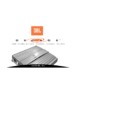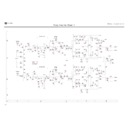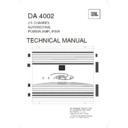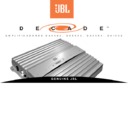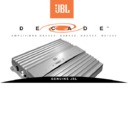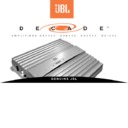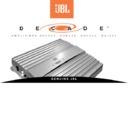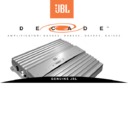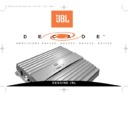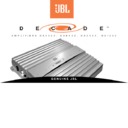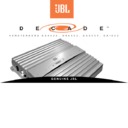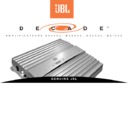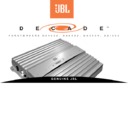JBL DA 4002 (serv.man3) User Manual / Operation Manual ▷ View online
4
Wiring the Speaker Output
Connections
Connections
1. Connect the speakers, observing
proper polarity, to the speaker output
barrier strip on the amplifier using at
least 16G high-quality speaker wire.
(Note: The total impedance of the
speakers connected to the outputs
when the amp is driven in stereo must
be at least 2 ohms.)
barrier strip on the amplifier using at
least 16G high-quality speaker wire.
(Note: The total impedance of the
speakers connected to the outputs
when the amp is driven in stereo must
be at least 2 ohms.)
2. If you are bridging the amplifier, con-
nect the speaker wires to the terminals
marked “bridge”, observing proper
polarity. (Note: The total impedance of
the speaker system to be connected to
the amplifier must be at least 4 ohms
in bridge mode.)
marked “bridge”, observing proper
polarity. (Note: The total impedance of
the speaker system to be connected to
the amplifier must be at least 4 ohms
in bridge mode.)
3. If you are running the amp in Tri-Mode
(stereo and mono simultaneously to
one or two pairs of satellite speakers
and a subwoofer), refer to the chart
below to determine the capacitor and
inductor values you’ll need to route
bass signals to the woofer, and
midrange and high frequencies to the
satellite speakers. These passive
crossover components will also ensure
that the impedance of the speaker
system doesn’t drop below 2 ohms.
one or two pairs of satellite speakers
and a subwoofer), refer to the chart
below to determine the capacitor and
inductor values you’ll need to route
bass signals to the woofer, and
midrange and high frequencies to the
satellite speakers. These passive
crossover components will also ensure
that the impedance of the speaker
system doesn’t drop below 2 ohms.
Wiring the Input Connections
1. If you are using conventional RCA
input connections and a source unit
with output voltage less than 4V, sim-
ply plug the RCA plugs into the RCA
jacks on the amplifier.
with output voltage less than 4V, sim-
ply plug the RCA plugs into the RCA
jacks on the amplifier.
2. If you are connecting the amplifier to a
factory-installed source unit, or to a
source unit that only has speaker-level
outputs, connect the speaker outputs of
the source to the speaker input plug on
the amp using the connector provided.
source unit that only has speaker-level
outputs, connect the speaker outputs of
the source to the speaker input plug on
the amp using the connector provided.
Mounting the Amplifier
The JBL Decade Series amplifiers can be
mounted in virtually any location inside
the vehicle. However, make sure to keep
the amplifier away from heater vents or
ducts.
1. At the chosen site, use the amplifier
mounted in virtually any location inside
the vehicle. However, make sure to keep
the amplifier away from heater vents or
ducts.
1. At the chosen site, use the amplifier
as a mounting template and mark the
locations of the four mounting holes.
locations of the four mounting holes.
2. Drill a small pilot hole at each marked
location.
3. Mount the amplifier and securely
tighten the mounting screws.
Wiring the Power Connections
Refer to diagrams on page 3 for connec-
tor locations.
1. For power, remote and speaker wires,
tor locations.
1. For power, remote and speaker wires,
strip 1⁄4" off one end of each jacket to
reveal bare wire for insertion into the
barrier strip connectors.
reveal bare wire for insertion into the
barrier strip connectors.
2. Locate the 3-connection barrier strip
labeled +Batt, Rem and Gnd. Connect a
black wire (at least 12G for DA4002,
10G for DA6502, DA1002 and DA3504)
to the Gnd terminal and connect the
other end to the nearest bare-metal
chassis component. Then, connect a
red wire (at least 12G for DA4002, 10G
for DA6502, DA1002 and DA3504) from
the vehicle’s +12-volt battery terminal
to the +Batt terminal on the barrier
strip. Finally connect a blue wire (16G)
to the Rem terminal on the barrier strip
and connect the other end to the Rem
output of the source unit.
black wire (at least 12G for DA4002,
10G for DA6502, DA1002 and DA3504)
to the Gnd terminal and connect the
other end to the nearest bare-metal
chassis component. Then, connect a
red wire (at least 12G for DA4002, 10G
for DA6502, DA1002 and DA3504) from
the vehicle’s +12-volt battery terminal
to the +Batt terminal on the barrier
strip. Finally connect a blue wire (16G)
to the Rem terminal on the barrier strip
and connect the other end to the Rem
output of the source unit.
FREQUENCY
INDUCTOR
CAPACITOR
Crossover
6dB/oct. LP
6dB/oct. HP
(4 ohm)
(4 ohm)
75Hz
8.0mH
530µF
100Hz
6.4mH
400µF
125Hz
5.0mH
318µF
150Hz
4.2mH
265µF
175Hz
3.6mH
227µF
200Hz
3.2mH
198µF
DA OM 7/14/98 11:38 AM Page 4
5
Observe the following color-codes:
Left+: White
Left–: White with black stripe
Right+: Gray
Right–: Gray with black stripe
Left+: White
Left–: White with black stripe
Right+: Gray
Right–: Gray with black stripe
4. If you are connecting your Decade
Series amplifier to a source unit with
output voltage higher than 4V, connect
the output signal wires of the source
unit to the floating ground factory head
unit inputs. Because the inputs have an
impedance of 100K ohms, this connec-
tion will provide the best noise-free
performance possible.
output voltage higher than 4V, connect
the output signal wires of the source
unit to the floating ground factory head
unit inputs. Because the inputs have an
impedance of 100K ohms, this connec-
tion will provide the best noise-free
performance possible.
System Setup and Adjustment
Electronic Crossover
The electronic crossover(s) in your
Decade Series amplifier can be selected
as a 12dB/oct. high-pass filter at 120Hz
(HPF), a 12dB/oct. low-pass filter at 80Hz
(LPF) or it can be defeated (FLAT).
The electronic crossover(s) in your
Decade Series amplifier can be selected
as a 12dB/oct. high-pass filter at 120Hz
(HPF), a 12dB/oct. low-pass filter at 80Hz
(LPF) or it can be defeated (FLAT).
Setting Input Sensitivity
Proper input sensitivity control settings
on Decade Series power amplifiers are
critical to ensure optimum performance,
low noise levels and maximum system
reliability. As a general rule, controls at
the front end of a system (source, equal-
izers and other processors) should be set
as high as possible with the amplifier
input sensitivity set as low as possible
while still providing adequate volume lev-
els. Using a high signal level and a low
sensitivity setting will help keep back-
ground noise in the system to a
minimum.
Proper input sensitivity control settings
on Decade Series power amplifiers are
critical to ensure optimum performance,
low noise levels and maximum system
reliability. As a general rule, controls at
the front end of a system (source, equal-
izers and other processors) should be set
as high as possible with the amplifier
input sensitivity set as low as possible
while still providing adequate volume lev-
els. Using a high signal level and a low
sensitivity setting will help keep back-
ground noise in the system to a
minimum.
Initially, turn the input sensitivity GAIN
control to its minimum (counter-clock-
wise) position.
1. Reconnect the (–) negative lead to
control to its minimum (counter-clock-
wise) position.
1. Reconnect the (–) negative lead to
your vehicle’s battery. Apply power to
the audio system and play a favorite
music track from a CD or tape. (Note:
After the source unit is on, the JBL
badge (on the top panel) will illumi-
nate, indicating the amplifier is on. If
not, check the wiring, especially the
remote connection from the source
unit. Also refer to “Troubleshooting”
on page 7.)
the audio system and play a favorite
music track from a CD or tape. (Note:
After the source unit is on, the JBL
badge (on the top panel) will illumi-
nate, indicating the amplifier is on. If
not, check the wiring, especially the
remote connection from the source
unit. Also refer to “Troubleshooting”
on page 7.)
2. On the source unit, increase the volume
control until it is approximately 3/4 of
its maximum output level. Slowly
increase the Input Sensitivity control
(clockwise) toward three o’ clock and, at
the same time, listen to the quality of
the reproduced sound.
its maximum output level. Slowly
increase the Input Sensitivity control
(clockwise) toward three o’ clock and, at
the same time, listen to the quality of
the reproduced sound.
At some point, you’ll hear distortion
on the music peaks. Stop the adjust-
ment and turn it back slightly. This is
the maximum undistorted output level
of your system, and should not be
exceeded during use.
on the music peaks. Stop the adjust-
ment and turn it back slightly. This is
the maximum undistorted output level
of your system, and should not be
exceeded during use.
3. After adjusting the level of the main
speakers in your system, you should
adjust the remaining channels (if you
are using a DA3504 or a multi-amp
system) for the desired system bal-
ance. You’ll find this easiest to do by
adjusting the channels in the following
order: 1) front speakers, 2) rear speak-
ers, 3) subwoofer. Elaborate, multi-
channel systems may be too complex
to adjust. Your local JBL installation
specialist is the best person to help
with such adjustments.
adjust the remaining channels (if you
are using a DA3504 or a multi-amp
system) for the desired system bal-
ance. You’ll find this easiest to do by
adjusting the channels in the following
order: 1) front speakers, 2) rear speak-
ers, 3) subwoofer. Elaborate, multi-
channel systems may be too complex
to adjust. Your local JBL installation
specialist is the best person to help
with such adjustments.
DA OM 7/14/98 11:38 AM Page 5
Applications
For your convenience, we’ve included
several application diagrams to help you
plan your own system installation.
Figures 1 through 4 show how to config-
ure the Decade Series power amplifiers
for stereo, bridged-mono and tri-mode
operation.
several application diagrams to help you
plan your own system installation.
Figures 1 through 4 show how to config-
ure the Decade Series power amplifiers
for stereo, bridged-mono and tri-mode
operation.
(Note: For simplicity, figures do not
show power, remote and input connec-
tions.)
Figure 1. This wiring diagram shows a
DA4002, DA6502 amplifier set to stereo
to drive a pair of full-range speakers.
Figure 2. This wiring diagram shows a
DA1002 amplifier set to bridge mode
(mono) to drive a single subwoofer.
Figure 3. This wiring diagram shows a
DA4002, DA6502 amplifier set for tri-
mode operation. For a desired crossover
frequency, use the chart on page 4 to
select an inductor for the subwoofer,
and corresponding capacitors for left
and right speakers.
Figure 4. This wiring diagram shows a
DA3504 set to drive a pair of 5-1/4"
2-way speakers with the two front
channels, and the rear channels set
to drive a single subwoofer in bridge
mode.
show power, remote and input connec-
tions.)
Figure 1. This wiring diagram shows a
DA4002, DA6502 amplifier set to stereo
to drive a pair of full-range speakers.
Figure 2. This wiring diagram shows a
DA1002 amplifier set to bridge mode
(mono) to drive a single subwoofer.
Figure 3. This wiring diagram shows a
DA4002, DA6502 amplifier set for tri-
mode operation. For a desired crossover
frequency, use the chart on page 4 to
select an inductor for the subwoofer,
and corresponding capacitors for left
and right speakers.
Figure 4. This wiring diagram shows a
DA3504 set to drive a pair of 5-1/4"
2-way speakers with the two front
channels, and the rear channels set
to drive a single subwoofer in bridge
mode.
6
SPEAKER OUTPUT
+
–
RIGHT
+
–
LEFT
+
–
POWER
REM
GND(
–
) BATT(
+
)
FUSE
BRIDGED
15 AMP
15
+
–
+
–
LEFT
RIGHT
+
–
BRIDGED
SPEAKER OUTPUT
POWER
FUSE
20 AMP
REM
GND(
–
) BATT(
+
)
20
SPEAKER INPUT
LINE INPUT
R
L
BASS EQ
INPUT
LEVEL
L
+
–
–
+
R
R
L
OFF
6dB
+
1
10
CROSSOVER
LPF
HPF
FLAT
SPEAKER OUTPUT
+
+
+
–
–
+
–
POWER
REM
GND(
–
) BATT(
+
)
BRIDGED
RIGHT
LEFT
FUSE
20 AMP
20 AMP
20 AMP
20
20
L
L
+
+
–
–
+
–
R
R
R
+
–
SPEAKER INPUT LINE INPUT
R
L
1
10
BASS EQ
INPUT LEVEL
L
OFF
6dB
+
LOW PASS
FILTER
OFF
70Hz 100Hz
SPEAKER INPUT
L
L
L
+
–
+
–
R
R
R
LINE INPUT
1
10
BASS EQ
INPUT
LEVEL
CROSS OVER
OFF
6dB
+
LPF
HPF
FLAT
+
–
+
–
+
–
REAR
LEFT
RIGHT
+
–
+
–
LEFT
RIGHT
BRIDGED
+
–
BRIDGED
SPEAKER OUTPUT
FRONT
POWER
FUSE
30 AMP
REM
GND(
–
) BATT(
+
)
30
SPEAKER
INPUT
INPUT
MODE
SPEAKER
INPUT
INPUT
MODE
STEREO
MONO
L
+
–
R
+
–
LINE INPUT
R
L
1
10
BASS
EQ
BASS
EQ
INPUT
LEVEL
INPUT
LEVEL
CROSS
OVER
CROSS
OVER
OFF 6dB
+
OFF 6dB
+
LPF
HPF
FLAT
LPF
HPF
FLAT
1
10
LINE INPUT
R
L
STEREO
MONO
L
–
–
R
+
–
Figure 1
Figure 2
Figure 3
Figure 4
DA OM 7/14/98 11:38 AM Page 6
7
Symptom
Likely Cause
Solution
No audio
Low/no remote on voltage
Check connections; turn-test turn-on voltage
Speakers are not connected
Check wiring; use VOM/DVM to measure speaker coil
or are blown
resistance
Distorted audio
Input sensitivity is not set properly
See Setting Input Sensitivity on page 5
Audio lacks “punch”
Speakers are wired with
Check polarity of connections; refer to Applications
wrong polarity
Audio cycles off and on;
A protection circuit is turning
Verify the following: off electrical system is between
amber protection LED
amplifier off and on
5 ~ 18 Vdc; temperature is not over 194°F (90°C);
(JBL badge on top panel)
no short circuits; speaker loads are not less than 2 ohms
is not lit
(4 ohms in mono)
Audio cycles off and on;
GAIN is set too high
Set Input Sensitivity correctly (see page 5)
amber protection LED
(JBL badge on top panel) is not lit
(JBL badge on top panel) is not lit
Fuse blows
Incorrect wiring or
Check connections; refer to Applications
short circuit
Declaration of Conformity
Kongevejen 194B
DK-3460 Birkerød
DENMARK
DK-3460 Birkerød
DENMARK
declare in own responsibility, that the products
described
in this owner’s manual are in compliance with technical
standard:
EN 55 020/6.1988
Steen Michaelsen
Birkerød. DENMARK. 3/98
Troubleshooting
Use the following guide to identify
symptoms and solve problems. Make
sure the vehicle’s electrical system is
working properly and power is reaching
the amplifier’s power connector.
symptoms and solve problems. Make
sure the vehicle’s electrical system is
working properly and power is reaching
the amplifier’s power connector.
DA OM 7/14/98 11:38 AM Page 7
Display

